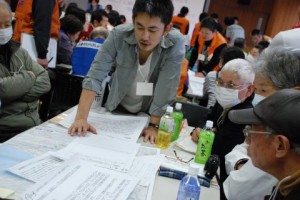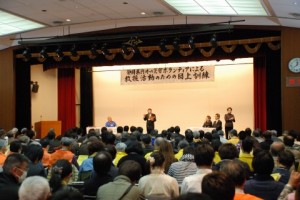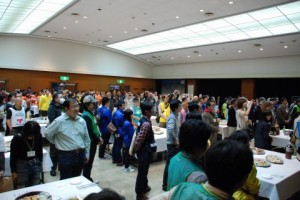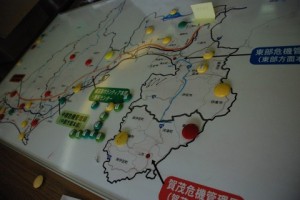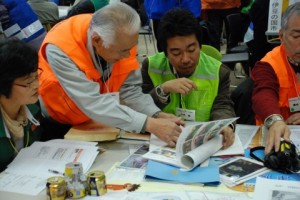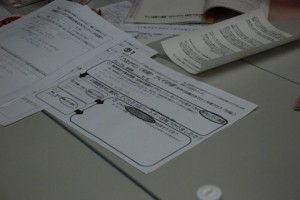
News
PBV at the GNDR (Global Network of Civil Society Organisations for Disaster Reduction) conference in the Hague, Netherlands
April 11, 2013
PBV’s Takashi Yamamoto attended the GNDR (Global Network of Civil Society Organisations for Disaster Reduction) conference organised by the United Nations in the Hague, Netherlands on March 20th and 21st.

There were 130 individuals in attendance, including special representatives of the ISDR (International Strategy for Disaster Reduction).
One of PBV’s main goals at this conference was to share the experiences and lessons learned in the wake of the Great East Japan Earthquake with members of the international community, creating a stronger knowledge base for future disaster reduction strategies.
There were 4 representatives from 3 Japan-based organisations in attendance; Church World Service Asia-Pacific, JANIC and PBV.
This conference served as an opportunity for PBV’s Yamamoto to make a presentation about the crucial relationship between communities resilient to disasters and the role of disaster relief volunteers.
As natural disasters are so frequent in Japan, the overall system of coordinating and dispatching volunteers has been through many stages of trial-and-error, resulting in the formation of a unique system.
This is highlighted by the relationship between NPOs/NGOs and the state-run social welfare councils (or shakyo) in disaster relief volunteerism, which may be unfamiliar to the wider international community.
In 2005, 10 years after the Great Hanshin-Awaji Earthquake, the Hyogo Framework for Action (HFA) was announced and the HAP (Humanitarian Accountability Partnership) Standards for humanitarian aid workers emerged in the same period. However, the role of disaster relief volunteers is still vastly under-represented in these documents.
With PBV’s experience in the field as well as the efforts of the thousands of volunteers who have volunteered with the organization, it is a high priority that we share our knowledge and experiences with the rest of the world.
*1 Hyogo Framework for Action
The Hyogo Framework for Action (HFA) is the first plan to explain, describe and detail the work that is required from all different sectors and actors to reduce disaster losses. It was developed and agreed on by many partners needed to reduce disaster risk – governments, international agencies, disaster experts and many others – bringing them into a common system of coordination. The HFA outlines five priorities for action, and offers guiding principles and practical means for achieving disaster resilience. Its goal is to substantially reduce disaster losses by the year 2015. The strategy relies upon building the resilience of nations and communities to disasters. This means reducing the loss of human life, as well as social, economic, and environmental assets when disasters strike.
*2 Resilient
The word resilience, in this context, refers to the ability to evade and/or mitigate the damage caused by disasters. This includes not only physically preventative measures and methods of disaster risk reduction, but also comprehensive education and training of communities in non-disaster times to raise awareness and encourage preparedness.
TAGS: Disaster Relief • Hague • Hyogo Framework for Action • United Nations • Yamamoto Takashi
Report from the ‘Disaster Prevention Training Camp’
April 1, 2013
PBV held an overnight Disaster Prevention Training Camp on March 23rd and 24th near the scenic town of Nagataro, Saitama prefecture.

The training program was presented as a joint effort by multiple groups, each with their own expertise and knowledge, which helped to create a truly in-depth and comprehensive course. The Chichibu Fire Station Kitabun precinct, WMA (Wilderness Medical Associates) Japan, Montbell and speakers from Ishinomaki city were amongst the many parties involved.
There were 28 participants, most of whom were based in the Kanto area. The group included not only past PBV volunteers, but students, office workers, and even some eager individuals from as far afield as Osaka.
The main purposes of the Disaster Prevention Training Camp are as follows:
- To have the participants gain a comprehensive understanding of disaster situations.
- To have the participants acquire the knowledge and mentality needed to protect one’s self and others in the case of a disaster.
- To have the participants make relationships and to create a network of disaster responders.
The course started with a simulation exercise, in which participants are given a scenario where there has just been a major earthquake. In this case there were fires and many casualties. Participants were trained to conduct preliminary assessments, provide CPR, use an AED, and also practiced extinguishing fires.
After having learned the basics, advanced classes were held in the field. It is presumed that at the time of a disaster, those in need of medical support may be outside wearing winter clothes. Two representatives of WMA Japan, Ohta and Yokohiro, conducted workshops in giving medical treatment in the wilderness with only basic equipment.

After lunch, participants learned about evacuation centers. Using a map (in a simulated situation), the participants thought about what would be necessary for each shelter to function. They were presented with different situations and had to think about how they could assess the problem as effectively as possible, exercising their decision-making skills.
This also served as an opportunity to learn about the Sphere Standards on humanitarian aid, making it possible to compare the differences between Japan and other countries from a humanitarian standpoint.
At night, the participants made a special dinner. To simulate a disaster situation, water could not be used to cook. So that day’s meal was prepared using the ‘plastic bag’ technique. This method is gaining popularity as a healthy way to cook, not needing any oil, but it is also very useful in an emergency for it does not need a bowl and only a minimal amount of water.
At night Yoshinobu Bandai from Ishinomaki city came to give a talk. Mr. Bandai’s life changed dramatically after 3.11 as he had lived in the area most of his life and was directly affected by the disaster. He spoke about his experiences in Northern Kyushu as a volunteer after the region was hit by heavy rainfall. He also spoke of his time in New York, where he took part in relief activities post-Hurricane Sandy in late 2012.
At the end of the day, they slept in a large room, using sleeping bags. This was also a part of the shelter experience. Men were separated from the women, which would be a luxury in a real situation, but snoring continued throughout the night.
Day Two
The second day started off with an optional activity.
Those who decided to join in were taken to the portable toilet and washing areas. They were taught crucial skills such as pulling water to the portable toilets, setting up lights and handling equipment. It’s easy to miss, but these seemingly simple tasks are indispensable in an emergency situation.
Next, the focus was on how to light kerosene burners and use generators. After breakfast, Handa from Montbell came and held a practical outdoor class. Since the Niigata Chuetsu Offshore Earthquake, Montbell has been present at many disaster-affected areas to provide support, applying their knowledge of the outdoors and survival techniques to the disaster relief scene.
The final lesson centered around cooking. The trainer for this lesson was PBV staff member Kazumi Kitamura, who was one of the main coordinators in providing food for those affected by 3.11.
Even for a person who cooks at home on a regular basis, cooking for people during a disaster is a totally different experience and requires a different skill set. The group was split up into teams in order to take on the tasks of managing the cooking utensils, preparing food and condiments, the cooking itself, distributing food and cleaning up afterwards.
*A portion of the ingredients used to make this meal was provided by Marubeni-Itochu Steel Inc.
After the program had concluded we gathered feedback during the debriefing. One of the participants remarked that they would like to do something in their local area to protect their family and friends. Another expressed his wish to have an overnight training program in more inconvenient and severe circumstances.
This being the first ‘Disaster Prevention Training Camp’, the staff that took part in preparing and conducting the program were also able to learn. As we are constantly looking to improve our trainings, we will be using the feedback we received to create an even better experience for future participants.
If you were not able to join us this time, we look forward to hosting you in the future!
To conclude, here are some words from Mr. Bandai.
‘You have to live first. To make sure you do not burden others, make sure you live.’
—
The following is an excerpt from Mr. Bandai’s letter of thanks:
An unbelievable tremor and tsunami! At nature’s will, there was nothing we could do but just stand there feeling hopeless.
When we had lost our path and felt only worries, there were those that came to us stretching out a hand of hope and joy asking if we were alright.
Those were the ones who saw what had happened on TV and felt the need to do something and decided to volunteer their time and energy to help out.
The volunteers came to an unknown place to help people they had never met.
They brought their own water, food and tents when coming, without being able to use a bath, drink alcohol or enjoy entertainment, they kept on working so hard to make the city clean, battling the piles of rubble and muck day after day.
Seeing these volunteers strive day in and day out, I and the people around me were able to truly live.
If you do not call what the volunteers showed towards us the ‘kindness of man’, then what would you call it? If not the ‘warmth of man’ then what else could it be?
I would like to show again my gratitude to all the volunteers that gave love, courage, and spirit towards the restoration of our home, to us that had lost everything.
Thank you,
Yoshinobu Bandai
Finally we would like to thank everyone that worked with us to conduct the ‘Disaster Prevention Training Camp’.
[Host] PBV Center
[Organizations involved] Chichibu Fire Station Kitabun precinct, Montbell Ltd., WMA Japan, Marubeni-Itochu Steel Inc.
[Support] Church World Service-Asia/Pacific
【Shinjuku】 “Introduction to Disaster Volunteer Training” held in English and Burmese
March 27, 2013
On March 3rd, PBV held an event called “Introduction to Disaster Volunteer Training: Training for Foreigners Living/Working in the Shinjuku Area” in Totsuka, near where PBV’s Tokyo office is located. The course was taken by 12 participants from 6 countries, including Burma, many of whom live in the Totsuka area.
This training session was organized in cooperation with the NPO Japan Association for Refugees (JAR). Both of our organizations have offices in Shinjuku and have been active in providing disaster relief to the Tohoku disaster areas.
Another unique trait that PBV and JAR share is that both organizations have involved many non-Japanese volunteers in our relief activities.
JAR has created its own “Disaster Handbook,” outlining what to do in the aftermath of a disaster. The book has been translated in to Simple Japanese, English, Burmese, Turkish, and Amharic.
JAR’s main focus is providing support for refugees who are residing in Japan.
When the earthquake and tsunami occurred, they immediately went to work dispatching volunteers to Tohoku. In 2011 alone, they coordinated international volunteers (including 200 refugees) for over 2,800 work days around Rikuzentakata in Iwate prefecture.
The JAR bureau chief, Ms. Ishikawa, gave a brief history of the organisation and introduced their activities.

As previously mentioned, PBV has sent groups of English speakers and Japanese/English bilingual volunteers to help with the relief effort in Onagawacho, Ishinomaki city in Miyagi prefecture.
So far, we have dispatched international volunteers from 56 countries around the world, totaling over 3,500 work days.

This training session also included several of our past international volunteers.
For foreigners who can’t easily read or write Japanese, the lack of information in the event of an emergency makes them disadvantaged during disasters. Foreigners comprise approximately 10% of the population in Shinjuku, and we wanted to change that way of thinking about them as people who are “disadvantaged” in a disaster, to “people who need support” in a disaster.
In that sense, they could be added to the same category as persons with disabilities, the elderly living alone, or infants and nursing mothers. Then, as “people who need support,” those 70,000 people would become part of the group that actually receives support.
*The above calculations are based on the number of registered residents; the current number of people who have applied as persons in need of support during a disaster is a little over 2,000 people.

Of course, there is still a lot of work to be done, but the experiences and successes of JAR and PBV prove that if we can just fill in the information gap caused by language differences, then it will be much easier to serve the foreigners who live and work in our community.
In other words, if we can only improve the methods of providing information in multiple languages, it will be possible to reduce the number of “disaster victims receiving support” and increase the number of “allies able to provide support.”

This photo shows several of our Burmese participants taking the training course with the help of simultaneous interpretation. Providing this kind of interpreting service and distributing emails and flyers in multiple languages is rather time-consuming at the start. But once you get used it, it is a relatively smooth process.

We also made some adjustments to the Japanese version of the training that is usually delivered.
For example, explaining that those in need of assistance should call “119″ for both emergency first aid and in the fire department; this may seem obvious to someone who has lived in Japan for a long time, but this may not be so well known among the foreign communities.

When cultural differences come into play, people may think about a subject differently even if the language of communication is the same. So we try to use photos to show the volunteers what kinds of tools they would need, and have the actual objects on display whenever possible.
In the workshop, we used a “Disaster Management Cycle” chart to illustrate what to do in the event of an earthquake in the city and how to be as prepared as possible.
This was the first time we held a class on disaster volunteering geared towards non-Japanese participants.
Many people had never heard about items like “disaster-prevention goods” and had no idea where to buy them. After the workshop, many told us that they had gained extremely useful information, and they would be sure to pick up some emergency-related gear in the near future.
Even better, several said that they would be interested in volunteering as well.
In Japan right now, the low birthrate and aging population is leading to an ever-decreasing number of youngsters. Even if we try to involve young people and engage them in volunteerism, as we did after the Hanshin and Tohoku earthquakes, this will not suffice in the event of a major disaster.
Disaster volunteerism will always play an important role after any disaster. However, we must also be able to mobilize enough people.
We believe this is the perfect time to expand the disaster volunteerism framework to include volunteers from all countries, regardless of their mother tongue.
Shizuoka – Volunteer Disaster Drill Preparing for Tokai Earthquake
March 26, 2013
PBV’s President Takashi Yamamoto and Programme Officer Yasuhiro Ueshima participated in the “Drill for Rescue Activities by Volunteers inside/outside of Shizuoka Prefecture” (2nd & 3rd March 2013).
This drill was hosted by Shizuoka Volunteer Association.
Those in attendance included disaster risk reduction and disaster support specialists, representatives of the Japan National Council of Social Welfare, a range of NPOs and a number of academics.
Representing PBV, Mr. Yamamoto has been an active part of a research team from the Volunteer Activities task-force coordinated by the Japanese government.
Shizuoka is widely regarded as a prefecture with an advanced and comprehensive disaster risk reduction strategy.
One of the reasons it has gained this reputation is that it has defined a unique role for disaster volunteerism . In this prefecture, disaster relief volunteers are believed to play a crucial role in disaster time and so are included in disaster preparedness drills.
Here in Japan, volunteers are often considered as an unreliable source of assistance as there is no way of telling whether they will show up when needed.
In the wake of the Great East Japan Earthquake and Tsunami, local communities were generally not well prepared to accept volunteers as this had not been flagged as a priority.
But thinking about it, who would fully prepare ahead of time for someone without knowing whether or not they would show up?
In fact, contrary to this belief, it has been proven that volunteers in recent years consistently show up after all kinds of disasters, not only earthquakes.
Behind the scenes, the Disaster Volunteer Center system spear-headed by the Social Welfare Council, along with the influence of various NGOs/NPOs, has been one of the key players in disaster relief activities.
Despite many challenges, Shizuoka is probably the only prefecture that has implemented large-scale disaster drills which include a specific role for volunteers for 9 consecutive years.
During this two-day drill, a total of 423 people from 196 organizations/groups participated.
This also proved to be an opportunity to form friendships and strengthen ties between organisations, as there were also workshops and parties for the participants.
In the event of a major earthquake in the Shizuoka area, municipalities will not only set up Disaster Volunteer Centers but they will also create a “Prefectural Volunteer Reception Center”, as well as a “Prefectural Disaster Volunteer Headquarters/Information Centre”.
By doing so, they are creating a more comprehensive and dependable volunteer intake system.
During the drill, PBV simulated entering Fuji City after a major disaster.
Participants created action plans for 2013 in order to consolidate their learning from the drills and to build upon what they had learnt at the event.
The Shizuoka prefectural government held this event in order to improve preparations and test response mechanisms which would be necessary if the Great Tokai Earthquake were to occur.
We all worry about disasters.
Disaster risk reduction, mitigation and response is heavily dependent on how much preparation and training is undertaken beforehand.
Rather than resigning ourselves to being powerless victims, we can take a more active role in being as prepared as possible for the next disaster.
Peace Boat and the Post 2015 Hyogo Framework for Action
March 19, 2013
Building Disaster Resilient Communities – Communities cannot be resilient in Isolation
“It takes people to support people”
Peace Boat and the Post 2015 Hyogo Framework for Action
The Hyogo Framework for Action 2005 – 2015 (HFA) is a 10-year plan to make the world safer by building the resilience of nations and communities to disasters. The HFA came out of the UN World Conference on Disaster Reduction 2005 (WCDR) a milestone event to increase the profile of disaster risk reduction (DRR).
In the lead up to the UN World Conference on Disaster Reduction to be held in Japan in 2015, Peace Boat’s Disaster Relief Volunteer Center will be attending international preparative conferences to share our experiences and give recommendations for the post-HFA 2015 environment.
1. GNDR Global Conference on People-Centred Resilience – The Hague, 20-21 March 2013.
The Global Network for Disaster Reduction (GNDR) is a major international network of non-governmental and not-for-profit organisations committed to working together to improve the lives of people affected by disasters world-wide.
2. The Fourth Session of the Global Platform For Disaster Risk Reduction – Geneva, 19-23 May 2013.
The Global Platform for Disaster Risk Reduction (GPDRR) is now the world’s foremost gathering of stakeholders (governments, NGOs and civil society, international agencies and organizations, academic and technical institutions, and the private sector) committed to reducing disaster risk and building the resilience of communities and nations. The Global Platform is organized by UNISDR, the UN’s office for disaster risk reduction and secretariat of the International Strategy for Disaster Reduction.
Peace Boat (an NGO in Special Consultative Status with the Economic and Social Council of the United Nations) began its disaster relief work following the Kobe earthquake of 1995, and since then has provided disaster relief support in Japan and around the world. Following the Great East Japan Earthquake and Tsunami of 2011, Peace Boat established the Peace Boat Disaster Relief Volunteer Center (PBV) to focus on emergency relief and DRR, specializing in the training and coordination of volunteers.
Since the Great East Japan Earthquake and Tsunami of 2011, Peace Boat Disaster Relief Volunteer Center has trained, despatched and coordinated 12,941 volunteers for a total of 79,797 working days (period between 17 Mar 2011 and 31 Dec 2012) during the response and recovery phases. PBV’s Training Programme is being delivered to volunteers and community members for the mitigation and preparedness phases and also pays particular attention to the training of leaders.
Based on this experience, Peace Boat Disaster Relief Volunteer Center has formulated a Goals and Action Statement to present at these conferences.
STRATEGIC GOALS
- Strengthen the capability and capacity of community and volunteer organisations through improving the management and coordination of volunteers
- Strengthen the strategic role of the community and volunteers in all phases of DRR
- Building disaster resilient communities – Communities cannot be resilient in isolation
PEACE BOAT “ACTION POINTS”
- Work towards developing “How to make YOUR community more resilient – a handbook for community members” inspired by the UN “How to make cities more resilient – A handbook for local government leaders”
- Develop and implement a training programme for community members and volunteers that gives them the skills to strategically manage and coordinate their communities and design their own Disaster Risk Reduction Plan (DRRP) and Disaster Response Plan (DRP)
- Bring community and volunteer groups together to facilitate better understanding and cooperation in DRR, through networking, exchange programmes, conferences etc.
- Build a resource pool to enable a quick pre-planned response in time of need
Relevant Documents
Building Disaster Resilient Communities Statement (Peace Boat Disaster Relief Volunteer Center) (English – PDF)
2012 Annual Report – 11 March 2011 – 31 March 2012 (Peace Boat Disaster Relief Volunteer Centre) (English – PDF)




























